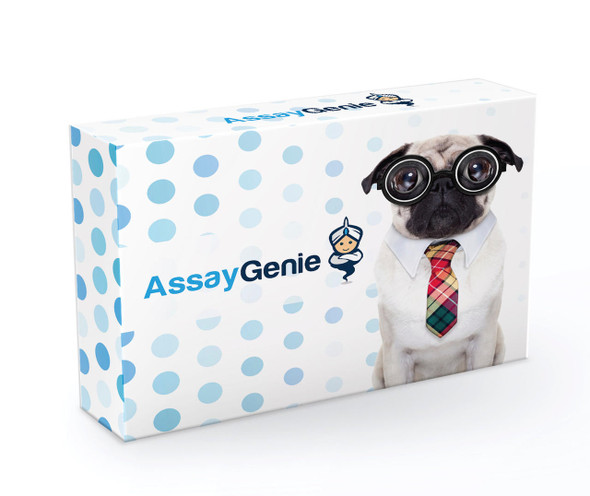Description
| Product Name: | Mouse CCL6 (Chemokine C-C-Motif Ligand 6) Quickstep ELISA Kit |
| SKU: | AEES02637 |
| Size: | 96 Assays |
| Detection Method: | Colorimetric method, ELISA, Sandwich |
| Assay Type: | Sandwich-ELISA |
| Sensitivity: | 4.69 pg/mL |
| Range: | 7.81-500 pg/mL |
| Reactivity: | Mouse |
| Sample Volume: | 50 μL |
| Total Assay Time: | 1 h 30 min |
| Recovery: | 80%-120% |
| Kit Components: |
| ||||||||||||||||||||||||||||||||||||||||||||||
This ELISA kit uses the Sandwich-ELISA principle. The micro ELISA plate provided in this kit has been pre-coated with an antibody specific to Mouse CCL6. Samples (or Standards) and Horseradish Peroxidase (HRP) linked antibody specific for Mouse CCL6 are added to the micro ELISA plate wells. Mouse CCL6 in samples (or standards) combines with the coated antibody and HRP linked detection antibody special to Mouse CCL6.Excess conjugate and unbound sample or standard are washed from the plate. The substrate solution is added to each well. The enzyme-substrate reaction is terminated by the addition of stop solution and the color turns yellow. The optical density (OD) is measured spectrophotometrically at a wavelength of 450±2 nm. The OD value is proportional to the concentration of Mouse CCL6. The concentration of Mouse CCL6 in the samples is then determined by comparing the OD of the samples to the standard curve.
| Standard: |
| ||||||||||||||||||||||||||||||||||||||||||
| Linearity: |
| ||||||||||||||||||||||||||||||||||||||||||
| Recovery: |
| ||||||||||||||||||||||||||||||||||||||||||
| Precision: |
| ||||||||||||||||||||||||||||||||||||||||||
*Note:The below protocol is a sample protocol. Protocols are specific to each batch/lot. For the correct instructions please follow the protocol included in your kit.
| Step | Protocol |
| 1. | Determine wells for diluted standard, blank and sample. Add 50 μL each dilution of standard, blank and sample into the appropriate wells (It is recommended that all samples and standards be assayed in duplicate. It is recommended to determine the dilution ratio of samples through preliminary experiments or technical support recommendations). Immediately add 50 μL of HRP Conjugate working solution to each well. Cover the plate with a new sealer. Incubate for 60 min at 37°C. Note: solutions should be added to the bottom of the micro ELISA plate well, avoid touching the inside wall and causing foaming as much as possible. |
| 2. | Decant the solution from each well, add 350 μL of wash buffer to each well. Soak for 1 min and aspirate or decant the solution from each well and pat it dry against clean absorbent paper. Repeat this wash step 5 times. Note: a microplate washer can be used in this step and other wash steps. Make the tested strips in use immediately after the wash step. Do not allow wells to be dry. |
| 3. | Add 90 μL of Substrate Reagent to each well. Cover the plate with a new sealer. Incubate for about 15 min at 37°C. Protect the plate from light. Note: the reaction time can be shortened or extended according to the actual color change, but not more than 30 min. Preheat the Microplate Reader for about 15 min before OD measurement. |
| 4. | Add 50 μL of Stop Solution to each well. Note: adding the stop solution should be done in the same order as the substrate solution. |
| 5. | Determine the optical density (OD value) of each well at once with a micro-plate reader set to 450 nm. |
| Sample Type | Protocol |
| Serum: | Allow samples to clot for 2 hours at room temperature or overnight at 4℃ before centrifugation for 20 min at 1000×g at 2~8℃. Collect the supernatant to carry out the assay. Blood collection tubes should be disposable and be non-endotoxin. |
| Plasma: | Collect plasma using EDTA-Na₂ as anticoagulant. Centrifuge samples for 15 min at 1000×g at 2~8℃ within 30 min of collection. Collect the supernatant to carry out the assay. Hemolysed samples are not suitable for ELISA assay! Recommended reagents for sample preparation: 10×EDTA Anticoagulant. |
| Uniport ID: | P27784 |
| Sample Type: | serum, plasma, saliva, urine |
| Specificity: | This kit recognizes Mouse CCL6 in samples. No significant cross-reactivity or interference between Mouse CCL6 and analogues was observed. |
| Storage: | 2-8℃ |
| Expiration Date: | 6 months |
| Research Area: | Immunology |










